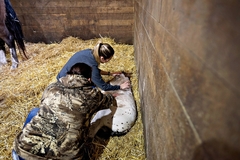
CROOKSTON, Minn. (March 29, 2021)- Hands-on learning is typical at the University of Minnesota Crookston, more so in March as students majoring in animal and equine science are in the heart of caring for newborns in several barns. It's lambing, kidding, calving, and foaling season on campus and Animal and Equine Science faculty, staff and students are busy providing support for both the lambs, kids, calves, foals and mothers.
“Our animal science majors really enjoy our classrooms! We call them the barns, labs, paddocks, and stables. There’s nothing quite like it, as our students are hands-on from day one,” says Animal Science Instructor, Terrill Bradford. Careers ranging from A-Z, including large and small animals. “We are talking about A (Animal Nutrition) to Z (Zoo Managers), and everything between,” Bradford says. At the University of Minnesota Crookston students get to work with cattle, goats, sheep, swine, and horses located right on the U of M campus in northwest Minnesota.
This month, several mares are on campus to foal. You can hear the mares whinny as you enter the University Teaching and Outreach Center stables. UTOC, built in the early ‘90s accommodated 25 horses for the Equine Management degree and three years later another 20 stalls were added to accommodate a growing academic program for an ever growing industry with the latest information technologies used by faculty, staff and students to take care of the University’s herd of 45 horses.
Nicky Overgaard, alumni and instructor of equine science at UMN Crookston said the equine science team uses live-streaming video technologies throughout the foaling season. “These horses are on our campus for two reasons, first to provide a comfortable environment for our partners' animals during birth and to provide a variety of teachable moments for our students. Hands-on is certainly the key within our Equine program,” says Overgaard.
“Our equine science, equine business management, animal science and pre-veterinary degrees provide a broad-based management education which appeals to employers,” Bradford said. She went on to say that UMN Crookston graduates understand and are able to manage the daily nutrition, health, and exercise/training needs of the animals in their care.
“The knowledge and skills necessary to succeed in equine or equine-related careers is what you’ll find here,” said Overgaard. Top it off with the business and management experience necessary to operate an equine or related business, both said the programs focus on the business and management aspects of the animal and horse industry while maintaining strong relationships with affiliated agriculture industries. It is those relationships created that provides a broad-based management education which appeals to employers.
Both degrees, equine science and animal science coursework includes computer and communications training, sales, and business management. Other required coursework is traditional to livestock, but students have the option of taking courses specific to their interests. Options also exist for students who wish to pursue pre-veterinary studies. UMN Crookston’s pre-vet emphasis, which is a science-based program, includes curriculum needed to get into veterinary college. Through these hands on activities students gain an extra edge by getting their hands on the animals for labs in every equine and animal science class. “They not only help in the birthing process, but also assist in breeding, genetics, nutrition, basic animal handling skills, vaccinations, and many other skills needed to be successful upon entry into a DVM program,” says Bradford.
“The students monitor the mares closely during foal watch,” said Overgaard. “When she’s close, the students will take turns staying overnight with her. Once parturition begins, the student will call faculty and staff to assist as well as others in their group so they can observe. It’s a really great experience for them to have.” The aftercare of the neonate foal and postpartum mare is just as important as students monitor them closely for their complete health and wellbeing.
Overgaard stated that these mares are on campus from partners who are looking for a safe environment for their animals. She said, while UMN Crookston has only been foaling for the last two years there is great potential for the students and our partners. “We would love more opportunities to aid our community, region and state.”
Among other things, both Overgaard and Bradford said the foaling, calving, and lambing teaches students another dynamic piece of the industry. “It is exciting to work with a horse that you’ve known for a while — perhaps since it was born, if only for a few weeks,” Overgaard said.



